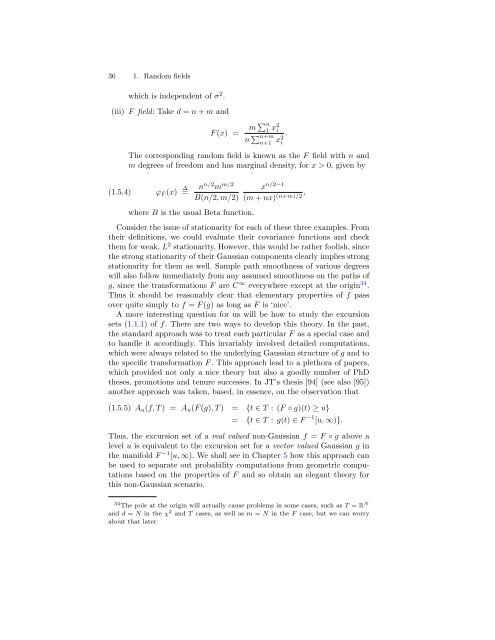Create successful ePaper yourself
Turn your PDF publications into a flip-book with our unique Google optimized e-Paper software.
36 1. Random fields<br />
which is independent of σ 2 .<br />
(iii) F field: Take d = n + m and<br />
(1.5.4)<br />
F (x) = m �n 1 x2i n �n+m n+1 x2 .<br />
i<br />
The corresponding random field is known as the F field with n and<br />
m degrees of freedom and has marginal density, for x > 0, given by<br />
ϕF (x) ∆ = nn/2 m m/2<br />
B(n/2, m/2)<br />
where B is the usual Beta function.<br />
xn/2−1 ,<br />
(m + nx) (n+m)/2<br />
Consider the issue of stationarity for each of these three examples. From<br />
their definitions, we could evaluate their covariance functions and check<br />
them for weak, L 2 stationarity. However, this would be rather foolish, since<br />
the strong stationarity of their Gaussian components clearly implies strong<br />
stationarity for them as well. Sample path smoothness of various degrees<br />
will also follow immediately from any assumed smoothness on the paths of<br />
g, since the transformations F are C ∞ everywhere except at the origin 34 .<br />
Thus it should be reasonably clear that elementary properties of f pass<br />
over quite simply to f = F (g) as long as F is ‘nice’.<br />
A more interesting question for us will be how to study the excursion<br />
sets (1.1.1) of f. There are two ways to develop this theory. In the past,<br />
the standard approach was to treat each particular F as a special case and<br />
to handle it accordingly. This invariably involved detailed computations,<br />
which were always related to the underlying Gaussian structure of g and to<br />
the specific transformation F . This approach lead to a plethora of papers,<br />
which provided not only a nice theory but also a goodly number of PhD<br />
theses, promotions and tenure successes. In JT’s thesis [94] (see also [95])<br />
another approach was taken, based, in essence, on the observation that<br />
(1.5.5)<br />
Au(f, T ) = Au(F (g), T ) = {t ∈ T : (F ◦ g)(t) ≥ u}<br />
= {t ∈ T : g(t) ∈ F −1 [u, ∞)}.<br />
Thus, the excursion set of a real valued non-Gaussian f = F ◦ g above a<br />
level u is equivalent to the excursion set for a vector valued Gaussian g in<br />
the manifold F −1 [u, ∞). We shall see in Chapter 5 how this approach can<br />
be used to separate out probability computations from geometric computations<br />
based on the properties of F and so obtain an elegant theory for<br />
this non-Gaussian scenario.<br />
34 The pole at the origin will actually cause problems in some cases, such as T = R N<br />
and d = N in the χ 2 and T cases, as well as m = N in the F case, but we can worry<br />
about that later.
















